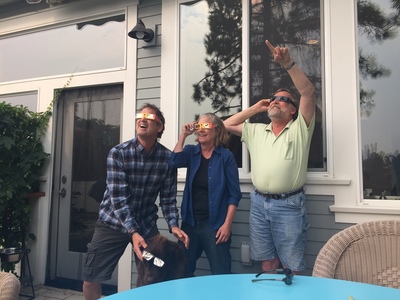 |
| A vain attempt by the Werme siblings at recreating a moment of eclipse viewing from the day before. |
 |
| A vain attempt by the Werme siblings at recreating a moment of eclipse viewing from the day before. |
| Or the real entry into totality as recorded on Doug's phone. |
When I discovered that a long drought in United States solar eclipses would finally break in 2017, and that the path of totality would pass near my brother's home, I told him to be there that day. My sister and her husband eventually decided they couldn't pass up the opportunity, and drove up from California while I flew out from New Hampshire.
One of the best pieces of advice I read about total solar eclipses, especially one's first, is to just take in the experience and not to see it through a camera's eyepiece. The dynamic range of film and digital cameras can't do justice to totality. There will be hundreds of good photos to see afterwards and dozens of great ones. I forgot to bring my camera anyway. That didn't even annoy me.
Besides, it turns out many things happen as the last few percent of the sun is covered, and cameras can't record them either.
However, cameras are useful. The photos below are Doug's camera and my cell phone. Click on any of them to see a larger version.
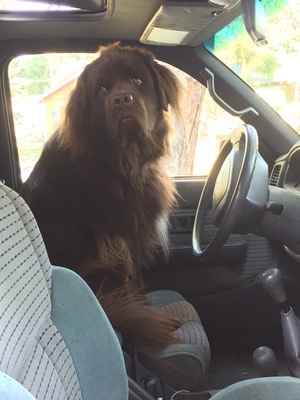 |
Dogs understand when people are packing a bunch of stuff. They also understand they may not be brought along, or worse, forgotten. "I'm ready. What's an eclipse, where is it, and did you pack food?" |
Doug's plan was to get to a good view spot on the day before the eclipse, in part to claim one of the spots he had picked out, and in part to have time to react to problems with the smoke or wildfires in the area.
When the forecast came out that called for clear weather on the coast, that meant there would be much less reason for heavy traffic coming across the Cascades from the coast and he picked out some potential spots on the western side.
On Sunday, when we got to Doug's prime spot, the smoke was a lot worse than a couple days before when he and I checked out roads in the area, and we decided to head across Santiam Pass to the western, wetter side of the Cascades and take whatever time we needed to find a good spot where we expected there would be much less smoke.
After lunch, dinner, and sleeping in tents came Doug's cheese and veggie omelets for breakfast and talk about the smoke smell that came through before dawn. Fortunately things were better now, and I hoped that we'd get some convection to draw clean air up the hillside before the eclipse began.
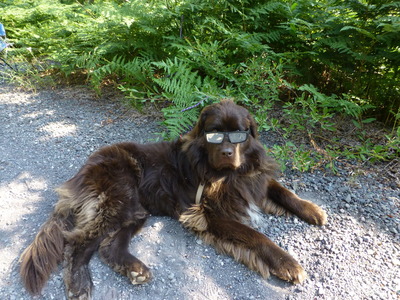 |
9:58 AM Georgy is more careful than our president! |
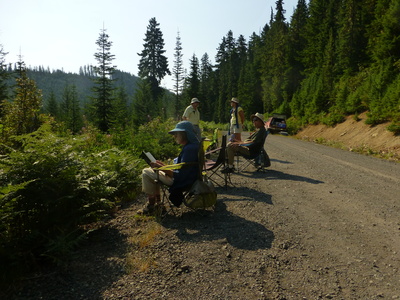 |
10:03 AM. While the camera can compensate for the level of lighting, I think
Doug deliberately underexposed this as the light much dimmer. The crescent
shape of the shadows gives the scene an odd appearance that I have never heard
adequately described. Silvery, actinic, crystalline are about the best
adjectives I've heard but are seriously lacking. I'm tempted to try to
reproduce it with a ring of LEDs that can be partially turned off.
This may capture some of the effect, note the dark shadows, but also the brightness of the sun reflecting off the leaves. The shadows become a lot sharper, at least in some directions, something you can sometime see with sunlight reflecting off a car's window and into the house. Our eyes' iris dilate to compensate for the dim light, but if you look at the sun, the result is the surface looks a lot brighter and just a glimpse is painful. I don't understand how anyone can watch an eclipse directly, but apparently there are still idiots who do so. |
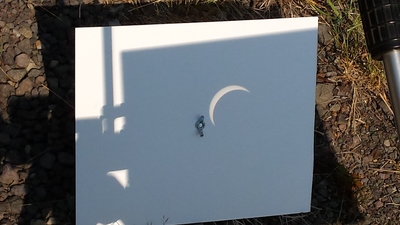 |
10:08 AM. Everything is getting dim except the sun's surface that's still exposed. Note the shadows from the tripod - some edges are fuzzy, some are sharp, and some are just weird. |
The run up into totality caught me a little off guard. The annular eclipse I saw covered only 89% of the sun. In this eclipse, the rate of obscuration increased all the way to totality as more and more of the moon's edge covered the sun. I concentrated on my projection as the crescent, now a thin line, faded away in sync with the daylight. In the seconds before totality, the sun dimmed far faster than I expected, and then suddenly bottomed out to something close to a night with a full moon. I looked to the horizon and saw the twilight from there, I looked up and saw the sun's corona, a motionless flame radiating from the black disk that was the moon. Doug handed me his binoculars and in a brief look I saw the prominences from the sun hanging close to the surface. I was very pleased to see they do look just as pink as they do in photos.
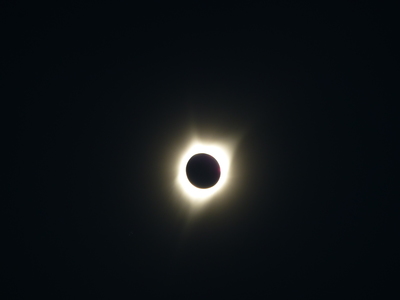 |
Doug managed to get a few photos with a point & shoot camera, this one turned out rather well. |
I remembered to look around for stars, and suddenly realized I had forgotten to check what would be near the sun. Off to the right was a brilliant star that I figured had to be Venus. Close to the sun were a few stars, I discovered later that the main ones were Regulus, Mercury, and Mars.
Totality ended all too soon. This time I kept watching the Sun. The time between the appearance of the diamond ring, the moment the sun first peeks out, to it being impossible to look at was only a few seconds. I had some thought of seeing the corona fade, but it was still visible when I had to look away. Looking back down, the light was coming back to the landscape as quickly as it left.
After a few comments about the experience, we joined in the post-eclipse activity to be repeated millions of times across the country, we packed up and left within a few minutes. Why not? The recovery is just as long as the entry, it goes through all the phases we had seen that morning, and none of them are anywhere near as stunning as what we just saw.
Contact Ric Werme or return to his home page.
Written 2017 Sep 3, last updated 2024 Apr 15.